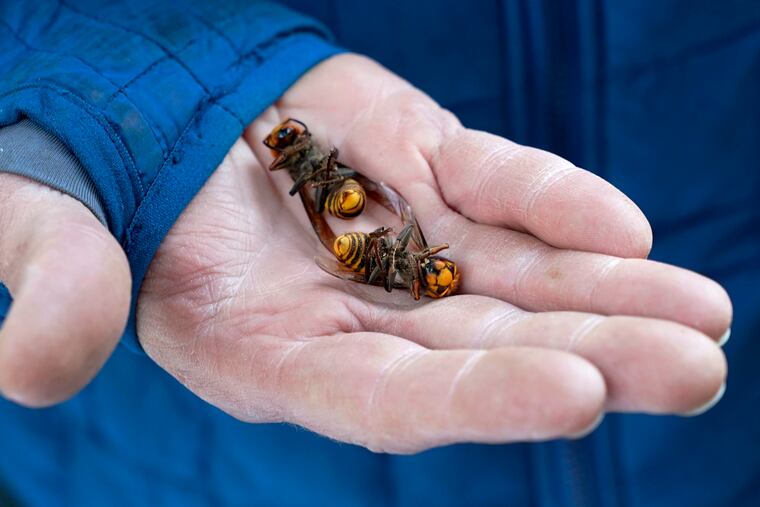If you’re in Pennsylvania, there’s almost no chance you saw a murder hornet
They are back in the news, but there has been no discovery of any Asian giant hornets anywhere in North America beyond those found in the Pacific Northwest.

Murder hornets — also known as Asian giant hornets — are back in the news this week.
The oversize insects are making headlines not because new outbreaks have been discovered since colonies were found and destroyed late last summer in Washington state and British Columbia — both on the West Coast of North America — but because people across the country remember the old headlines.
As temperatures warm, in places like Pennsylvania — about 2,000 miles east of the spots where the hornets from Asia were found — surprisingly large insects, like the European hornet and eastern cicada killer, have emerged here.
That has led to frantic phone calls and emails to state agencies, agriculture extension and the media. The calls began a couple weeks ago, but really surged this past weekend.
It has not led to the discovery of any Asian giant hornets anywhere in North America beyond those found in the Pacific Northwest.
» READ MORE: Asian giant ‘murder hornets’ buzz into U.S. Could they get to Philly area?
The European hornet, as the name implies, is a nonnative invader in the U.S., including Pennsylvania, but has been here since the 1840s. It can be one-and-a-quarter inches long and will be attracted to artificial light at night. The species also will defend its colony aggressively.
The eastern cicada killer is a native species. It’s highly nonaggressive toward humans, but usually gets swatted on sight simply because it can be nearly two inches long.
Either of the large insects easily outsize species like the more familiar bald-faced hornet, which maxes out at about three-quarters of an inch. A sudden sighting of either a European hornet or cicada killer can be a startling experience leading to the reflexive and immediate destruction of the insect.
But neither of those common insects are murder hornets, which at worst won’t be seen anywhere near Pennsylvania for many decades to come.
Queen murder hornets are more than two inches long. Workers are about an inch-and-a-half.
Beyond the size differences, the insects have recognizable differences in appearance.
The Asian giant hornet is broader than the other two, particularly in its head and face, which is both cartoonish and fierce, with large protruding, teardrop-shaped eyes.
The head of the Asian giant hornet is almost entirely yellow-orange, while the head of the eastern cicada killer is mostly black, and the head of the European hornet is reddish brown with more yellow near the face.
The orange and black stripes that extend around the abdomen of the Asian giant hornet, much like the stripes of a tiger, further distinguish the insect from its smaller cousins. The black bands on the Asian giant hornet are wider than those on the European hornet — roughly the same width as the orange bands — and of more uniform width than those of eastern cicada killer.
The black areas are much larger and more shield-shaped on the body of the eastern cicada killer, which has more black than orange on its body.
The European hornet has generally thinner bands of black (dark brown, actually) on its body than either of the other two.